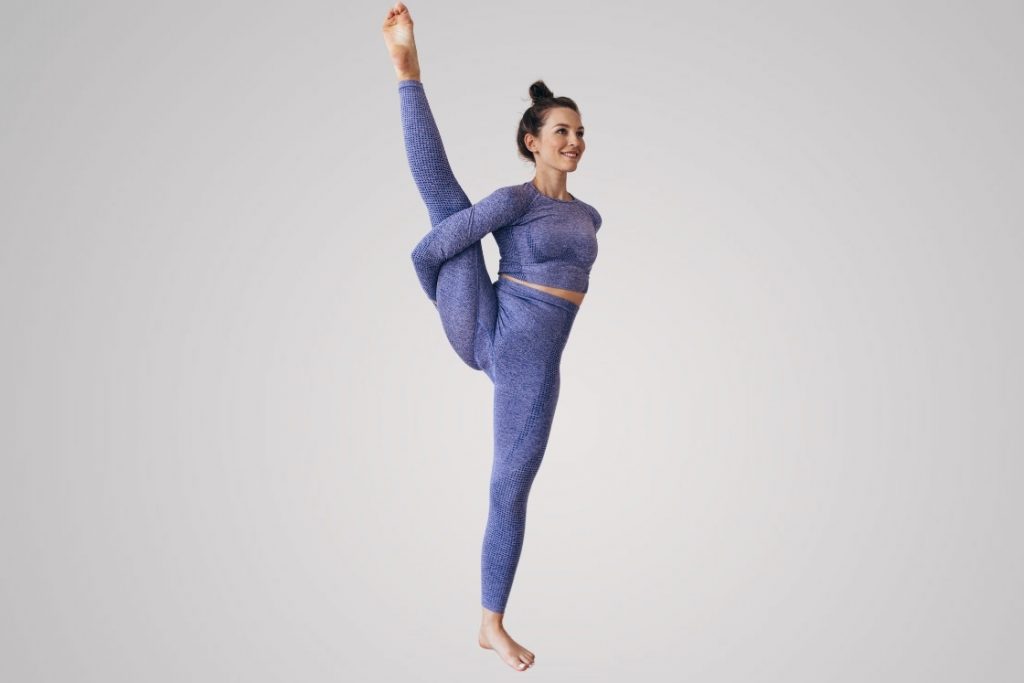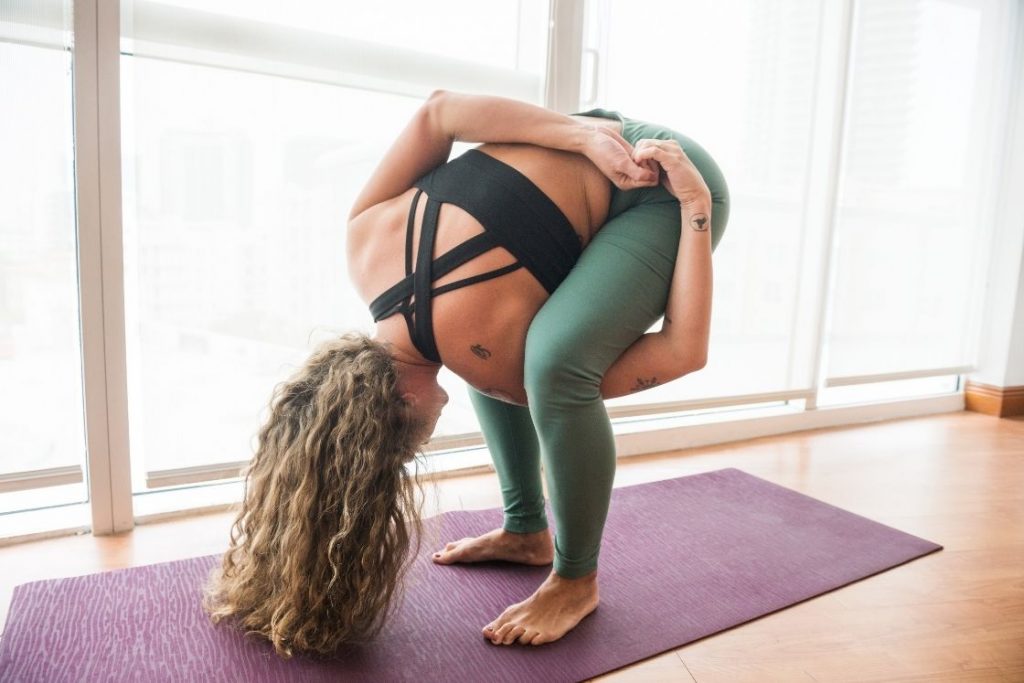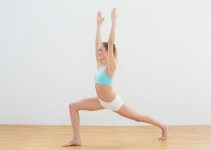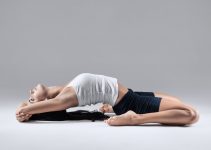
Bird of Paradise pose is an advanced yoga pose that will test your balance and flexibility. It dynamically involves standing posture; while maintaining balance on one leg, you stretch the opposite leg overhead.
The position of standing and stretching simultaneously in this pose makes it a wonderful chest and hip opener. This pose is good to target the area around the hip and pelvis by stretching your groin and hamstrings.
Keep on reading to know more about the meaning behind the pose name, its benefits, and how to do it.
Svarga Dvijasana Meaning
Bird of Paradise pose is known as Svarga Dvijasana in Sanskrit. Svarga means ‘heaven’, Dvij means ‘twice born’, and asana means ‘pose’. Though, the pose gets its name on the appearance of the flower ‘Bird of Paradise’ which grows horizontally on an elongated stalk.
Our body in the pose looks similar to the flower ‘Bird of Paradise’, the overhead stretched leg represents the vibrant petals of the flower and the balancing leg is similar to the long stalk. Whereas the bind, created by your arms opens your heart to vulnerability yet shows your strength to be fully open to the world.
In the spiritual context, the pose has a deeper meaning. Bird of Paradise pose lets you experience the depth of heaven (Svarga) and totally newborn energy (Dvij) in the body by activating Kundalini at Root Chakra (Muladhara) and creative force at Sacral Chakra (Svadhisthana). Spiritually speaking, you will experience the intensity of heaven and create a deep connection to the divine by standing tall in this pose.
Practice guide to Bird of Paradise pose
Let us have a look at the tips to keep in mind, the steps to perform this pose, and the benefits of the pose.
Precautions and Contraindications
- Pregnant women should completely avoid practicing this pose, as the pressure on the abdomen can be a cause of discomfort for the mother and the fetus.
- If you have sustained a hip, back or shoulder injury, avoid this pose till you recover or your doctor or instructor checks that you can start performing this pose.
- For people suffering from high blood pressure, practice this pose in moderation or under guidance. The energy you require to keep in balance is through your heart, diaphragm, and breathing, which may cause a strain.
- Always be aware of any shooting pain or cramp in your legs and arms. If your body is not flexible, there is a high chance that you may pull a muscle. Stop performing right away in such cases and seek help.
- Although it is not recommended to practice this pose unless you have attained a certain level of stability, flexibility, and balance. However, if you are still performing it, you can take the support of a wall or a partner.
Preparatory Poses
- Mountain Pose (Tadasana)
- Humble Warrior Pose (Baddha Virabhadrasana)
- Extended Side Angle Pose (Utthita Parsvakonasana)
- Standing Hand to Big Toe Pose (Utthita Hasta Padangusthasana)
How to Do Bird of Paradise Pose

To perform this pose, you need to balance your body on one leg while stretching the other leg overhead. Your arms form a bind on the thighs of the stretched leg to give support. It is just like performing a split while standing.
Follow these step-by-step instructions to do this pose.
#Step 1. Start by coming to the bound side angle pose. For ease of explaining, let us assume that your right leg is bent, your left leg is extended back, and you are looking over your left shoulder.
#Step 2. Instead of looking up, look down towards your right foot. Your right elbow is placed below the thigh and your right hand is firmly holding the left wrist.
#Step 3. Keeping the bind in place, slowly bring your left leg forward and place it with your right leg. Straighten both your legs and hold this position for at least 3 breaths.
#Step 4. Engaging your abdominal muscles and putting some weight in the left leg, starting pulling up, bringing the bound leg up with you. Here, you can keep the knee bent till the time you find your balance.
#Step 5. The foot of the balancing leg should be firmly placed on the ground and the knees should be stacked on the ankle. The quadriceps of both legs should be contracted for balance and support and the hamstrings of the lifted leg should be engaged to support the opening and stretching.
#Step 6. When you have found your balance, stretch your leg fully overhead. Your toes should be relaxed yet pointed firmly towards the sky. Put some weight in the left hip to create a balance and be aware that the hips are squared towards the front.
You can either look forward or at the side on the opposite shoulder. Hold this pose for at least 3-5 deep breathes.
To come out of this pose, slowly bring your stretched leg down while bending the knee. Bend forward while placing your leg on the ground and release the arm bind. Pull yourself up and stand straight in a Mountain Pose (Tadasana).
Follow-up Poses
- Eagle Pose (Garudasana)
- Downward-Facing Dog Pose (Adho Mukha Svanasana)
- Dolphin Pose (Ardha Pincha Mayurasana)
- Corpse Pose (Shavasana)
Important tips for practicing the pose safely
As you can see that Bird of Paradise pose is quite intense and is using your leg and arm muscles. It is important that these muscles have been sufficiently stretched. Practice the art of binds by using them in variations in some deep poses.
This pose is also a hip opener hence you should make sure that the hamstrings, hip flexors, and glutes are flexible and open. Practice preparatory poses to warm up your body before attempting this pose.
Balance is another important factor in this pose. You should have previously performed asanas that will develop your balance, stability, and core strength.
Do not hesitate to use support in case you are finding difficulty in maintaining your balance.
Make sure that your shoulders are not hunched while making the bind.
Variations and modifications
To go deeper into the Bird of Paradise pose, modify it using the following variations.
- Instead of straightening the leg completely upwards, you can keep them bent at your knees to ease some strain. Build up muscle strength with regular practice.
- If you are in the initial stages of this pose, you do not need to stretch your leg completely upwards. Come halfway and try balancing this pose while keeping your stretched leg parallel to the ground in a way that your legs make an inverted ‘L’ shape.
- Rather than binding your arms at the thighs, hold your shin with one arm and keep the other arm parallel to the balancing leg.
- You can also increase the stretch in your arms and hold the toes of the upward stretched leg.
- Use a yoga strap to make the bind in case of any discomfort in your shoulders.
- Beginners can practice this pose by sitting on the chair for extra support.
- Another way to support your back is to perform this pose by lying down. It will act as a variation to the reclining head-to-big toe pose (Supta Padangusthasana).
- To enhance the difficulty level and experience a deeper opening, bend forward from the hips till your torso is parallel to the ground.
Benefits of Bird of Paradise Pose
1. It stretches the muscles of the entire body
From your legs to the arms that are creating the bind, each of the muscles involved in creating the bird of paradise pose is getting stretched.
The calves of the balancing leg, the deep stretch of the glutes, groin, and hips when the leg is stretched upwards, biceps and triceps of the arms, and your core and abdominal muscles are all being extensively stretched. This means that all these muscles have been engaged to produce the energy to hold this position.
2. Improves flexibility and balance through awareness
When you are stretching your leg upwards, you are also contracting your back muscles. This helps in removing any stiffness or stress present in that part of the body. You are also using your abdominal muscles and core strength to keep yourself balanced on one leg. All this creates a sense of awareness and regular practise of this pose will improve your flexibility.
3. Improves posture through the extension of the spine
Anyone with a hunched back or a stooped posture will surely benefit from the bird of paradise pose. In this pose, you are not only focusing on opening the hips and balancing but also need to be aware of keeping your back straight by extending your spine and opening your chest. In this process, you are allowing a fluid flow of the prana energy from the spine to the entire body which keeps your spine fit.
4. Enhances lung capacity and heart-pumping
The stretching of the leg and balancing requires intense awareness of your breathing. This awareness helps in the expansion and contraction of the diaphragm muscles, which in turn also expands your lungs. The expansion will invoke good oxygen circulation thereby supporting the heart to pump blood in a better way to the arms that are binding the leg and also to the leg that is balancing your body. As a result, it increases the prana flow as well.
Conclusion
Although the Bird of Paradise pose is a very challenging asana, it is one of those poses that will greatly improve your flexibility and balance. Your physical and mental strength is of utmost importance while practicing this pose. Apart from balancing and flexibility, it works wonders on de-stressing the muscles of the back, arms, and legs.
A great chest and hip opener, performing this pose perfectly and safely can only be achieved through patience and regular practice. No sooner, you will be able to replicate and feel the elegance and grace of its namesake!




